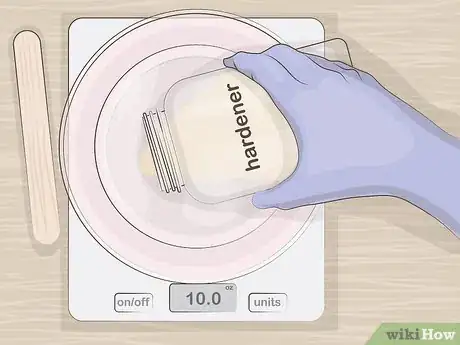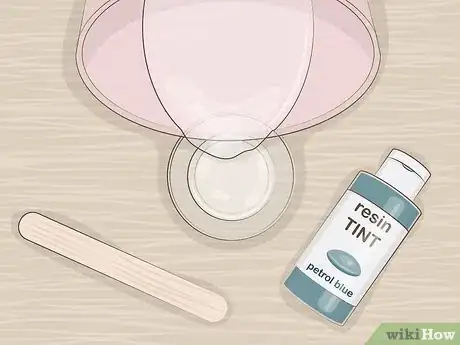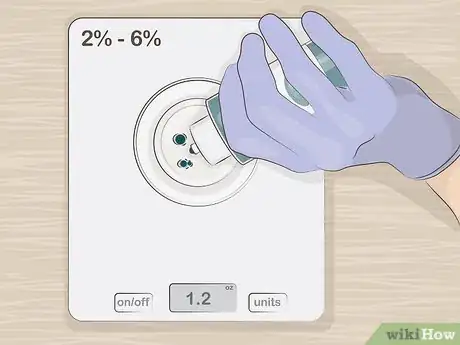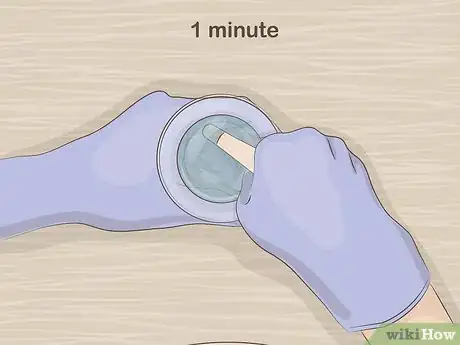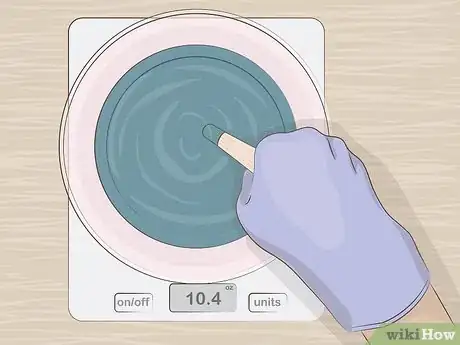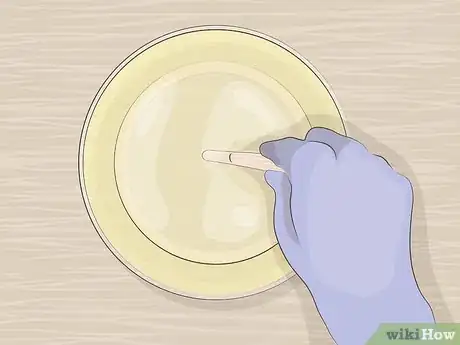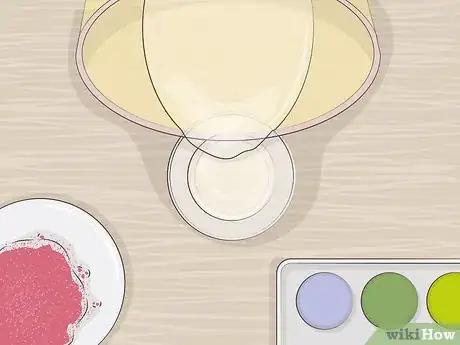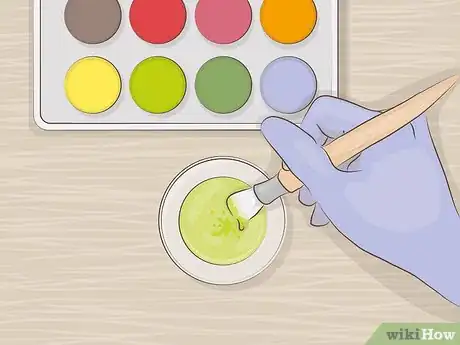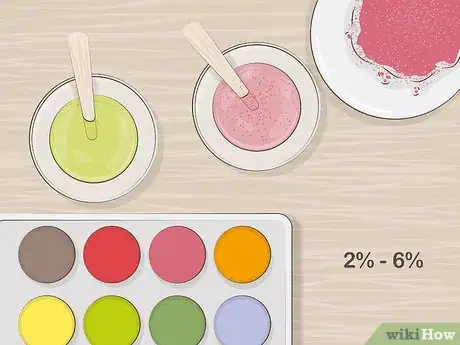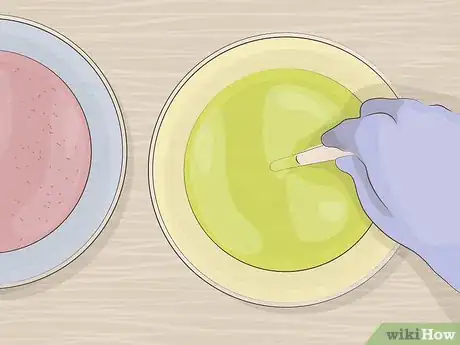This article was co-authored by wikiHow Staff. Our trained team of editors and researchers validate articles for accuracy and comprehensiveness. wikiHow's Content Management Team carefully monitors the work from our editorial staff to ensure that each article is backed by trusted research and meets our high quality standards.
wikiHow marks an article as reader-approved once it receives enough positive feedback. In this case, 95% of readers who voted found the article helpful, earning it our reader-approved status.
This article has been viewed 134,208 times.
Learn more...
Epoxy resin without any added colorants tends to end up with a slightly yellow hue that leaves much to be desired for most people. However, by adding liquid or powdered colorant to epoxy, you can create an aesthetically pleasing resin that can be used to enhance your do-it-yourself projects or add color to tabletops, chairs, and other furniture items around the house. You can use traditional colorants, such as paints and inks, or experiment with various household items to make your resin more colorful and artistic.
Things You Should Know
- Pour your mixed resin into a small cup and add enough paint, ink, or tint to make up 2-6% of the mixture's weight. Stir for 1 minute, and adjust the coloring as needed.
- Repeat the same coloring process with the rest of your epoxy resin once you're happy with the color you've created.
- Alternatively, use household items like chalk or toner powder to color your resin, or use a liquid colorant like watercolor paint for a smoother finish.
- With homemade colors, make sure the colorant is less than 6% of the resin's total weight. Color a small portion of the resin before coloring the rest of the batch.
Steps
Paint, Ink, or Tint
-
1Mix the resin if you haven’t already. You’ll need to mix your epoxy resin with a hardening agent before adding your colorant to it. Follow the instructions on your resin container to determine what is the proper ratio of resin to hardener you should use.[1]
- While there are plenty of paints, inks, and tints available on the market, most are not specifically intended to be used to color resin. For best results, purchase a paint or tint designed to bond with resin and bring out particularly saturated colors. [2] You can buy resin tints online or at nearly any crafting store.
- Be sure to wear eye protection (e.g., goggles) and rubber gloves to protect your eyes and skin during this procedure.
- If you’ve already mixed your resin and would like to color your leftover resin, you can skip this step.
-
2Pour a small amount of resin into a 1 fluid ounce (30 mL) mixing cup. Before adding your colorant to all of your resin, you’ll want to test it with a small amount of resin to make sure it produces a color that you like. Use a mixing container that includes volume measurements on the side for easier measuring.[3]
- For example, a small measuring cup used for dispensing cough syrup would work very well for testing resin colorants.
Advertisement -
3Add your colorant so that it makes up 2%-6% of the mixture’s weight. Slowly add the paint, ink, or resin tint to the mixing container, using a toothpick or other small stick to stir the mixture as you go. You can roughly estimate how much to add to make up 2%-6% of the mixture’s weight, or use a digital scale to precisely weigh your colorant and mixture.[4]
- Avoid going over the 6% weight limit, as adding this much colorant might disrupt the delicate chemical process that takes place in resin and that is necessary for it to be properly used.
- There is no harm in adding so little colorant that it amounts to less than 2% of the mixture’s weight. However, this may not be enough colorant to produce a different color in your resin.
- If you’re not sure how much colorant to add, err on the side of adding less than you think you might want. If it isn’t enough, you can always add more.
-
4Stir for about 1 minute and make sure there are no bubbles. You’ll want to ensure that your colorant is completely mixed into your resin and that the new color is applied throughout the mixture. Stir the resin until your resin is smooth and without air bubbles to ensure a smooth finish when applied.[5]
-
5Adjust the amount of colorant you use to achieve your desired look. If your newly colored mixture is not as colored as you wanted, add more colorant to the mixture and re-stir. If the color is more than you want, restart the process and add less colorant to the mixing container until you achieve the effect you want.[6]
- If changing the amount of colorant you use doesn’t produce results to your satisfaction, consider using a different type of liquid colorant or a non-liquid colorant from around the house.
-
6Repeat this process for the rest of your epoxy resin. Once you’ve achieved the results you wanted in the small mixing container, you can now repeat the process to safely color the rest of your resin. Make sure you use the same proportion of colorant as you did with the 1 fluid ounce (30 mL) mixture.[7]
- For example, if you used .25 fluid ounces (7.4 mL) of resin in your mixing cup to test the colorant and your overall amount of resin is 2 fluid ounces (59 mL), then you should multiply the amount of colorant you added to the mixing cup by 8 to determine the amount you should use in the rest of the resin.
Household Items
-
1Make sure your epoxy resin is mixed. If you haven’t already mixed your resin with a hardening agent, you’ll need to do so before proceeding. Follow the instructions that came with your resin to determine the proper ratio of resin to hardener you need to achieve.[8]
- Protect your eyes and skin by wearing safety goggles and rubber gloves as you carry out this process.
-
2Pour some of the resin into a 1 fluid ounce (30 mL) container. You’ll want to test your colorant in a separate mixing container to see how it affects your resin before adding it to the whole mixture. For best results, use a mixing container that includes volume measurements on the side.[9]
- For example, a good container to use would be a small measuring cup that comes with cough syrup.
-
3Use powdered pigments to leave tiny particles in the finished mixture. Powdered colorants like chalk, toner powder, and even herbs and spices will not only color your resin, but will also produce a grainy finish that might enhance your project.[10]
- You should definitely avoid using powdered pigments if you want your colored resin to have a smooth finish.
- Paprika is perhaps the most commonly used spice for coloring resin, but feel free to experiment with other granular spices in your kitchen to see which one works best for you and your project.
-
4Color with liquid pigments for a smoother, more consistent finish. Colorants such as children’s watercolor paint or dyes for home use can also be used to color epoxy resin. These produce a much smoother finish in your resin and are arguably easier for amateurs to mix with epoxy resin.[11]
- Nail polish and alcohol inks are also commonly used to color epoxy resin.
-
5Stir in the colorant so that it is less than 6% of the mixture’s weight. Whichever colorant you use, you’ll want to make sure you don’t add so much that it disrupts the chemical reaction that naturally takes place in resin. Aim to add an amount of colorant that would make up 2%-6% of the finished mixture, stirring as you add it to the resin.[12]
- If you’re not sure how much colorant to add, start out by adding a very small amount and continually increase the amount you use until it produces a satisfying color.
- Stir the mixture for about 1 minute, making sure there are no bubbles in the end result.
-
6Repeat this process for the rest of your resin. Add more colorant to the resin until it produces the color effect that you’re looking for. Then, once you're satisfied with the color of the resin in the mixing cup, add that colorant to the rest of your resin, making sure to use the same proportion of colorant as you did with the 1 fluid ounce (30 mL) mixture.[13]
- If you’re unable to achieve the effect you were hoping for, consider using a different type of colorant instead of a different amount.
Community Q&A
-
QuestionCan I use India inks to color resin?
 Community AnswerAlcohol is a solvent and is used for resin cleanup, so use alcohol inks sparingly with resin. Acrylic inks, on the other hand, have vibrant colors and are really the thinnest form of acrylic paint.
Community AnswerAlcohol is a solvent and is used for resin cleanup, so use alcohol inks sparingly with resin. Acrylic inks, on the other hand, have vibrant colors and are really the thinnest form of acrylic paint. -
QuestionCan I use eyeshadow to color resin?
 BhumikaCommunity AnswerYes, since eyeshadow is a type of pigment, you can scrape the eyeshadow and add the powder to the resin.
BhumikaCommunity AnswerYes, since eyeshadow is a type of pigment, you can scrape the eyeshadow and add the powder to the resin. -
QuestionHow about food coloring?
 Priyamvada ShekharCommunity AnswerYou can create an opaque colored resin with just a little bit of white pigment. You can use Market Pantry brand food color from Target as well as McCormick food color. They both work well.
Priyamvada ShekharCommunity AnswerYou can create an opaque colored resin with just a little bit of white pigment. You can use Market Pantry brand food color from Target as well as McCormick food color. They both work well.
Things You’ll Need
- Resin tint or paint
- Hardening agent
- Safety goggles
- Rubber gloves
- Mixing cup
- Toothpick
- Digital scale
- Powdered pigments
- Liquid pigments
References
- ↑ https://swellcomposites.com/blogs/news/step-by-step-guide-measuring-and-mixing-epoxy-resins
- ↑ https://www.artresin.com/blogs/artresin/what-can-you-use-to-color-clear-resin
- ↑ https://www.resinobsession.com/resin-resin-resin/experimenting-with-resin-colors
- ↑ http://epoxycountertopdiy.com/how-to-color-epoxy-resin/
- ↑ https://www.resinobsession.com/resin-resin-resin/experimenting-with-resin-colors
- ↑ http://epoxycountertopdiy.com/how-to-color-epoxy-resin/
- ↑ http://epoxycountertopdiy.com/how-to-color-epoxy-resin/
- ↑ https://swellcomposites.com/blogs/news/step-by-step-guide-measuring-and-mixing-epoxy-resins
- ↑ https://www.resinobsession.com/resin-resin-resin/experimenting-with-resin-colors
About This Article
To color your epoxy resin, try using paint or ink. First, add your resin to a measuring cup and add a small amount of paint or ink, which shouldn’t make up more than 6 percent of the mixture. Then, simply stir the resin for 1 minute with a toothpick or similar item, making sure there’s no bubbles left in the mixture, and you're done! If you don't have paint or ink, you can even use nail polish or paprika to color your resin. Follow the same process, making sure that your colorant doesn’t make up more than 6 percent of the mixture. For tips on how to make your resin grainy, read on!
